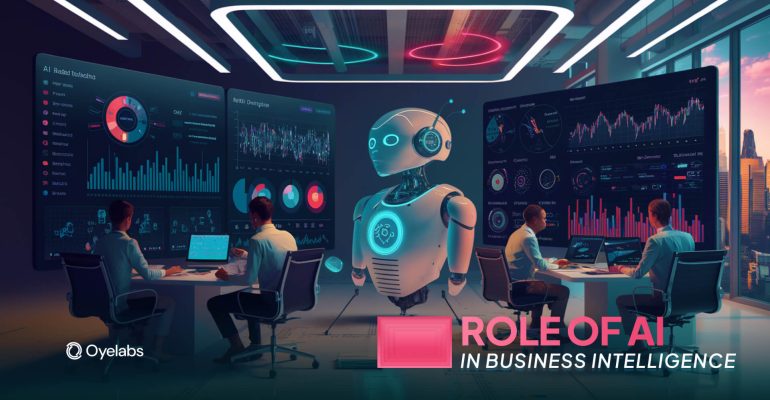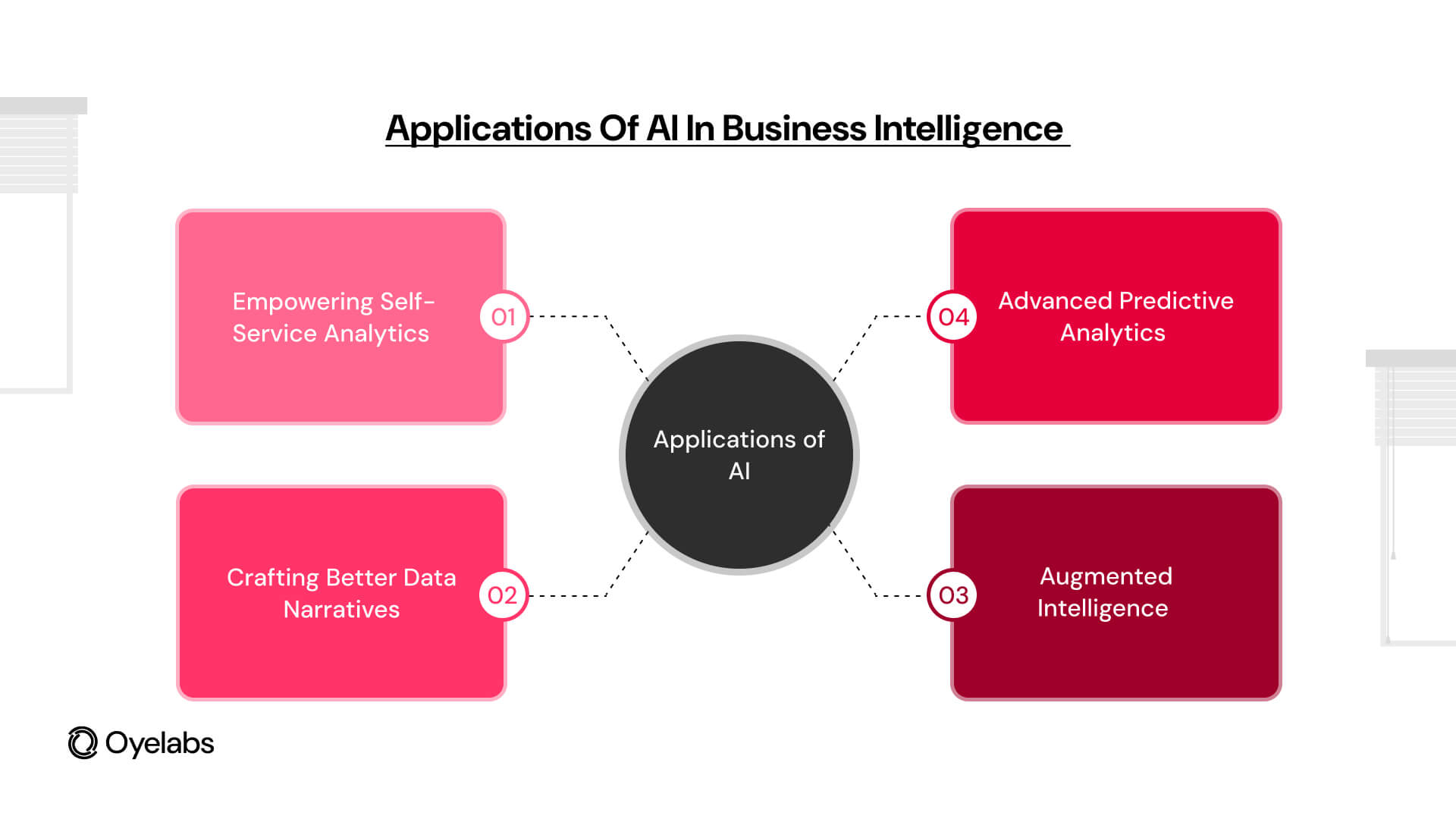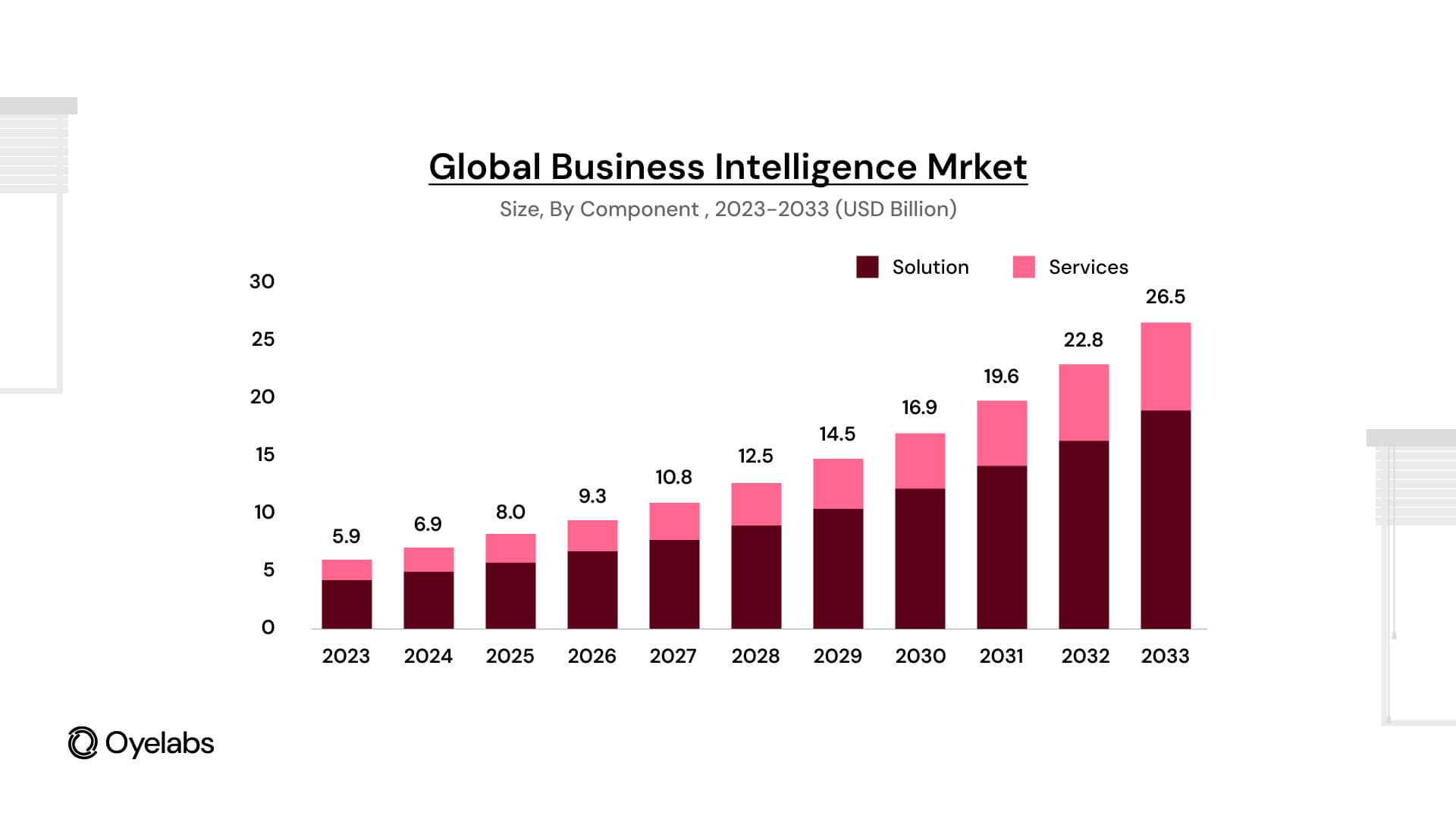The Role of AI in Business Intelligence (BI) in 2025

The Role of AI in Business Intelligence (BI) in 2025
Last Updated on March 3, 2025
Artificial Intelligence is making Business Intelligence smarter, faster, and easier to use. With 67% of the global workforce now using BI tools, businesses are relying on AI to analyze data, automate complex tasks, and make better decisions in real time. Instead of spending hours going through reports, companies can now get instant AI-driven insights to stay ahead.
AI in BI is more than just number-crunching. It helps spot patterns, predict future trends, and support smarter decision-making. From self-service analytics that let teams explore data on their own to AI-powered storytelling that turns numbers into insights, businesses are using AI to get more value from their data.
In this article, we’ll explore AI’s role in BI, its impact, applications, challenges, and how businesses can implement AI successfully.
The Impact of AI on Business Intelligence
Business Intelligence refers to the technologies, processes, and tools used to collect, analyze, and visualize data for better decision-making. Traditionally, BI solutions required significant manual effort, limiting their ability to interpret complex data sets efficiently. However, AI is redefining BI by automating processes, enhancing predictive analytics, and making insights more accessible.
With the global Business Intelligence market expected to grow from USD 5.9 billion in 2023 to USD 8 billion by 2025, businesses are increasingly adopting AI-powered BI tools to stay competitive. AI streamlines data collection, cleansing, and visualization, reducing the workload for analysts while improving accuracy. Real-time insights allow companies to respond proactively to market shifts, while machine learning enhances predictive analytics, helping businesses forecast customer behavior, optimize inventory, and manage risks effectively.
Additionally, AI-driven Natural Language Processing (NLP) makes BI more user-friendly, allowing non-technical users to query data using natural language instead of complex SQL commands. By integrating AI into BI, companies gain a competitive edge through improved efficiency, faster decision-making, and more accurate data-driven strategies.
Also Read: AI in the Metaverse
Applications of AI in Business Intelligence

Empowering Self-Service Analytics
Traditionally, businesses relied on data analysts to generate reports, often leading to delays in decision-making. AI-powered self-service analytics is changing this by enabling non-technical users to access, analyze, and interpret data independently. With 77% of companies either using or exploring AI applications, according to a National University report, self-service BI is becoming a key driver of AI adoption.
How AI Powers Self-Service Analytics
- Natural Language Processing (NLP): AI tools like ThoughtSpot allow users to query data in plain English, making analytics as simple as using a search engine.
- Automated Data Discovery: AI automatically identifies key insights, reducing the need for manual data exploration and speeding up decision-making.
- Interactive Data Visualization: AI-driven dashboards provide real-time insights, enabling users to drill down into specific data points and make data-driven decisions faster.
Real-World Example:
The healthcare company Wellthy leveraged AI-powered analytics to give its care team real-time access to patient data. By using ThoughtSpot’s NLP search, Wellthy improved efficiency, ultimately saving over $200,000 in operational costs. With companies increasingly investing in AI-driven BI solutions, PwC projects AI could contribute up to $15.7 trillion to the global economy by 2030, with $6.6 trillion coming from increased productivity.
Crafting Better Data Narratives
AI doesn’t just analyze data—it helps businesses tell compelling stories through interactive visualizations and automated reporting. With 83% of business leaders considering AI a strategic priority, according to a National University report, organizations are using AI to transform raw data into meaningful insights that drive action.
Benefits of AI in Data Storytelling
- Real-Time KPI Monitoring: AI-powered dashboards track key performance indicators (KPIs) in real-time, allowing businesses to respond to trends as they emerge.
- Predictive Insights: AI analyzes historical data to forecast future trends, providing businesses with a competitive advantage.
- Automated Report Generation: AI simplifies reporting by summarizing key insights in natural language, making complex data easier to understand.
Example: Enhancing Sales Strategies
Companies are replacing static reports with AI-powered dashboards that visualize sales trends, compare historical data, and highlight areas of potential growth. For example, retailers using AI-driven insights have seen a 20-30% increase in efficiency, according to a Boston Consulting Group (BCG) study. This ability to instantly transform data into actionable insights is driving more businesses to integrate AI-powered storytelling into their BI strategies.
Augmented Intelligence
AI enhances human intelligence by automating repetitive tasks, such as data preparation and cleaning, allowing analysts to focus on strategic decision-making. However, despite the potential benefits, 74% of companies struggle to scale AI value, as reported by BCG in 2024. The key to overcoming this challenge lies in augmented intelligence, where AI works alongside human analysts to improve efficiency and accuracy.
How AI Enhances Augmented Intelligence
- Automated Data Cleansing: AI detects and corrects errors in datasets, ensuring data accuracy.
- Data Integration: AI consolidates data from multiple sources into a single, reliable dataset.
- Human-in-the-Loop (HITL) Feedback: AI systems learn from human input, continuously improving over time.
Example:
AI-powered analytics tools like ThoughtSpot Spotter have achieved 95% accuracy in data insights by incorporating human feedback. This hybrid approach not only reduces errors but also boosts confidence in AI-driven analyses. With AI expected to increase productivity by 40% by 2035, according to a PwC report, businesses that embrace augmented intelligence will have a competitive edge.
Advanced Predictive Analytics
AI’s ability to forecast trends is transforming industries by enabling businesses to anticipate customer needs, detect fraud, and optimize operations. Predictive analytics is already widely used, with Gartner predicting that by 2026, over 80% of enterprises will use AI-driven analytics for decision-making.
Predictive Analytics Use Cases
- Retail: AI predicts inventory needs based on past sales data and seasonal trends, reducing stock shortages.
- Healthcare: AI forecasts patient admission rates, allowing hospitals to allocate resources more effectively.
- Finance: AI detects fraudulent transactions in real-time, improving security and preventing financial losses.
Machine Learning Models for Predictive Analytics: Businesses use machine learning models such as time series analysis to project future demand, regression models to estimate customer attrition, and clustering algorithms to segment customers for personalized marketing. AI-driven predictive models have already proven their value—financial institutions using AI for fraud detection have seen a 30% reduction in fraudulent transactions, according to a McKinsey report.
Also Read: AI in CRM
Challenges of Implementing AI in Business Intelligence
Artificial Intelligence is revolutionizing Business Intelligence (BI), but its implementation comes with significant challenges. From data quality issues to ethical concerns, businesses must navigate these obstacles carefully to maximize AI’s potential. Here’s a deeper look at these challenges and the strategies to overcome them.
Ensuring Data Quality
AI-driven BI systems are only as reliable as the data they analyze. A 2024 Gartner study found that only 4% of IT leaders consider their data AI-ready, highlighting widespread concerns about data accuracy, completeness, and consistency. Poor-quality data can result in misleading insights, leading businesses to make costly decisions based on incorrect information.
Solution:
- Implement rigorous data cleaning and standardization processes to eliminate duplicates, missing values, and inconsistencies. Automated AI-driven data cleansing tools can help streamline this process.
- Establish data governance policies to ensure consistency across departments. According to a 2023 Data Governance Institute report, organizations with strong data governance frameworks see a 40% reduction in data errors and improved AI accuracy.
- Regularly audit and validate datasets before feeding them into AI models. This ensures that business intelligence reports are based on high-quality, reliable data.
The Black Box Problem
One of the biggest concerns with AI-driven BI systems is their lack of transparency. Many AI models function as “black boxes,” meaning users cannot fully understand how decisions are made. This makes it difficult for business leaders to trust AI-driven insights, especially in industries like finance and healthcare, where transparency is critical.
Solution:
- Use explainable AI (XAI) techniques that provide insights into how AI models arrive at conclusions. According to an MIT Sloan study, businesses that implement XAI see a 30% increase in user trust and adoption of AI-powered decision-making.
- Implement human-in-the-loop feedback, where human analysts review AI-generated insights before they are acted upon. This approach enhances model transparency and allows experts to intervene when necessary.
- Opt for AI-powered BI tools that offer decision traceability, enabling businesses to track how data is processed and which variables influenced AI-generated recommendations.
Skills Gaps
Despite the rapid adoption of AI, many employees lack the technical expertise to effectively use AI-powered BI tools. A 2024 PwC survey found that 75% of companies are integrating AI into their business intelligence processes, yet only 35% of employees have received AI training. This skills gap limits AI’s potential impact and increases reliance on a small group of AI specialists.
Solution:
- Invest in AI training programs for employees at all levels. Companies that implement AI upskilling programs report a 20-25% improvement in workforce efficiency.
- Use low-code or no-code AI BI tools that require minimal technical expertise. Modern platforms like ThoughtSpot and Tableau integrate AI-powered analytics with simple drag-and-drop interfaces, enabling non-technical users to derive insights independently.
- Encourage cross-functional collaboration between data scientists and business teams to bridge the AI knowledge gap. Organizations with strong AI collaboration models experience a 60% faster AI adoption rate than those without.
Ethical Concerns and Bias
AI models learn from historical data, which means they can inherit biases present in that data. This can result in biased decision-making, leading to unfair hiring practices, discriminatory lending decisions, and other ethical concerns. A 2024 study by IBM found that 62% of business leaders worry about AI bias affecting their decision-making processes.
Solution:
- Regularly audit AI models for biases by testing them against diverse datasets and analyzing output patterns for discriminatory tendencies. Companies that perform frequent AI audits reduce bias-related errors by 45%.
- Implement ethical AI frameworks that ensure fairness, transparency, and accountability. The European Commission’s AI Ethics Guidelines emphasize fairness, explainability, and accountability as key principles for responsible AI use.
- Use bias-mitigation techniques such as synthetic data generation, adversarial testing, and fairness-aware machine learning models to reduce bias in AI-driven BI systems.
Also Read: Guide to AI Integration in Existing Systems
Best Practices for Deploying AI in Business Intelligence
Successfully integrating AI into Business Intelligence (BI) requires a strategic approach to ensure accuracy, security, and long-term value. Here are some best practices to help businesses maximize the benefits of AI-driven BI.
Define Clear Objectives
Before implementing AI in BI, it is crucial to establish clear goals. Businesses should determine what they aim to achieve, whether it is improving efficiency, enhancing decision-making, automating data analysis, or uncovering deeper insights. Clear objectives provide a framework for selecting the right AI tools and measuring success. For instance, a retail company may use AI to optimize inventory forecasting, while a financial institution may focus on fraud detection.
Invest in High-Quality Data
AI is only as good as the data it processes. Inaccurate, incomplete, or inconsistent data can lead to flawed insights and poor decision-making. To ensure reliability, businesses must invest in proper data collection, cleansing, and governance practices. A 2020 study by Accenture found that poor data literacy costs businesses over $100 billion annually. This highlights the importance of structured data management, ensuring AI models have access to accurate and relevant information for analysis.
Choose the Right AI Tools
Not all AI-powered BI solutions are the same, and selecting the right tools is key to success. Businesses should evaluate AI-driven BI platforms based on their industry, data complexity, and specific use cases. For example, Microsoft Power BI, which holds 36% of the BI market share (TrustRadius 2021), is a popular choice for businesses looking for user-friendly AI-powered analytics. Companies should look for platforms that offer automation, predictive analytics, and natural language processing (NLP) to improve accessibility and efficiency.
Ensure Data Security and Compliance
With AI-driven BI handling large volumes of sensitive business data, security and compliance must be a top priority. Companies must implement robust security measures, such as encryption, access controls, and regulatory compliance with data protection laws like GDPR and CCPA. According to a report by Accenture, 60-73% of all enterprise data remains unanalyzed, creating hidden security risks. Proper governance frameworks ensure AI systems operate within ethical and legal boundaries, minimizing data breaches and compliance violations.
Foster a Data-Driven Culture
AI-powered BI tools are most effective when employees actively use them in decision-making. Businesses should invest in training programs to improve data literacy and encourage teams to leverage AI insights. Despite AI adoption rising, only 35% of employees have received AI-related training, highlighting a major gap in workforce preparedness. By fostering a culture where data-driven decision-making is the norm, businesses can maximize AI’s impact on strategic growth and operational efficiency.
Monitor and Optimize AI Performance
AI models require continuous monitoring and refinement to maintain accuracy and efficiency. Over time, business needs, market conditions, and data patterns change, requiring adjustments to AI algorithms. Regular audits, feedback loops, and human-in-the-loop approaches can help refine AI insights. ThoughtSpot Spotter, for example, achieves 95% accuracy by incorporating human validation in its AI models. Businesses should track AI performance metrics and make necessary improvements to ensure long-term reliability.
By following these best practices, companies can effectively deploy AI in BI, driving better insights, efficiency, and competitive advantage in an increasingly data-driven world.
How Oyelabs Integrates AI in BI
At Oyelabs, we empower businesses with AI-driven Business Intelligence solutions that transform raw data into actionable insights. Our AI-enhanced marketing analytics help companies create personalized campaigns by analyzing customer behavior, increasing engagement and conversions. Through intelligent automation, we streamline business processes, reducing manual workload and improving efficiency. Our predictive business insights allow organizations to forecast market trends and sales performance, enabling proactive decision-making.
Additionally, our AI-powered security solutions identify and mitigate cybersecurity threats, ensuring data protection and compliance. By integrating AI into BI, we help businesses optimize operations, enhance decision-making, and gain a competitive edge in a data-driven world. With Oyelabs, companies can unlock the full potential of AI-powered analytics to drive growth and innovation.
Conclusion
AI is transforming business intelligence by providing faster, more accurate, and actionable insights. From self-service analytics to predictive modeling, AI enhances decision-making, automates processes, and personalizes customer experiences. However, challenges such as data quality, transparency, and ethical concerns must be addressed to maximize AI’s potential.
At Oyelabs, we specialize in integrating AI into BI systems, helping businesses turn data into strategic advantages. By embracing AI-powered BI solutions, organizations can drive innovation, improve efficiency, and stay ahead in an increasingly data-driven world.
Ready to enhance your business intelligence with AI? Contact Oyelabs today!




